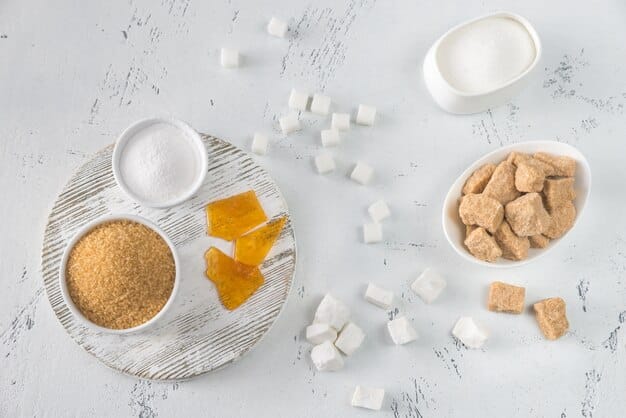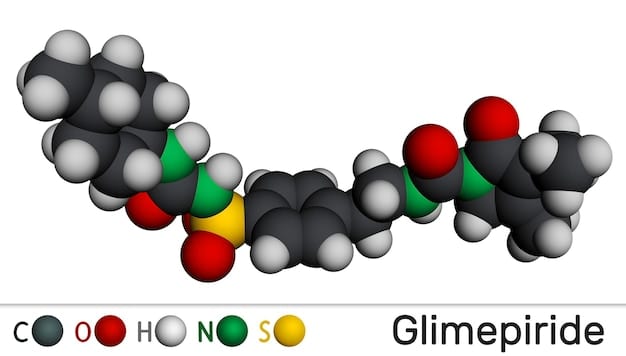Sugar Substitutes: Healthier Truth Unveiled

While often marketed as healthier sugar alternatives, the truth about sugar substitutes is complex, with emerging research suggesting potential long-term impacts on metabolism, gut microbiome, and overall health that warrant careful consideration beyond their immediate calorie reduction.
In a world increasingly conscious of health and wellness, sugar has become a primary target for dietary reduction. This has led to a proliferation of alternatives, but the truth about sugar substitutes: are they really healthier? The question resonates with millions seeking to manage weight, blood sugar, or simply live a more wholesome life. But beneath the promises of zero calories and guilt-free sweetness, lies a complex reality that demands closer inspection.
Understanding the Landscape of Sweeteners
The realm of sweeteners is vast and varied, extending far beyond the familiar granulated sugar. To truly grasp the implications of sugar substitutes, it’s essential to categorize and understand their origins and basic properties. This foundation helps to demystify the labels we encounter daily.
Types of Sugar Substitutes
Sugar substitutes are broadly classified into several categories, each with distinct characteristics and regulatory statuses. Understanding these differences is crucial for an informed perspective.
- Artificial Sweeteners: These are synthetic chemical compounds, often hundreds to thousands of times sweeter than sugar, providing minimal to no calories. Examples include aspartame, sucralose, saccharin, and acesulfame potassium.
- Natural Sweeteners: Derived from natural sources, these can include stevia (from the stevia plant), monk fruit extract, and sugar alcohols (polyols) like erythritol and xylitol. While “natural,” their processing can vary.
- Novel Sweeteners: A newer category encompassing ingredients like allulose, which is a rare sugar found naturally in small amounts, and tagatose, derived from fruits, which offer unique properties.
Each type interacts with the human body differently, influencing taste perception, metabolic responses, and even gut health in unique ways. The term “sugar substitute” itself can be a misnomer, as many do not replicate sugar’s chemical structure but rather its sweetening ability. This distinction is vital when evaluating their health impact.
For instance, artificial sweeteners were initially developed to provide sweetness without the caloric load, aiming to aid in weight management and control blood sugar levels for individuals with diabetes. Natural alternatives, on the other hand, often play on consumer preferences for less processed or “cleaner” ingredients, despite sometimes undergoing significant industrial processing themselves. The nuanced spectrum of these products reflects a complex interplay of scientific innovation, consumer demand, and regulatory oversight.
The Promise: Weight Management and Blood Sugar Control
For decades, the primary appeal of sugar substitutes has rested on two compelling promises: aiding in weight loss and managing blood sugar levels, particularly for those with diabetes. These claims are rooted in the fundamental characteristic of most sugar substitutes: their ability to provide sweetness with few to no calories or carbohydrates. The logic seems straightforward: less sugar means fewer calories, which should translate to easier weight management and more stable blood glucose.
Calorie Reduction and Weight
The substitution of caloric sugar with non-caloric sweeteners *theoretically* leads to a reduction in overall calorie intake. This simple equation has driven countless consumers to opt for “diet” sodas, sugar-free candies, and light yogurts.
- Reduced Caloric Load: By replacing sugar in foods and beverages, these substitutes significantly cut down on ingested calories, potentially creating a caloric deficit necessary for weight loss.
- Addressing “Sweet Cravings”: They allow individuals to satisfy their desire for sweet tastes without derailing dietary efforts, offering a psychological benefit.
- Dietary Flexibility: For many, sugar substitutes provide a way to enjoy familiar tastes without feeling completely deprived, which can improve adherence to a dietary plan.
However, the real-world impact on weight has proven to be less straightforward than the simple calorie-in, calorie-out model suggests. Observational studies have yielded mixed results, with some even showing an association between artificial sweetener consumption and weight gain, not loss. This paradox has spurred significant scientific inquiry into the physiological and behavioral mechanisms at play.
Impact on Blood Glucose and Diabetes Management
For individuals with diabetes, or those at risk, sugar substitutes offer an appealing alternative to sugar, as they typically do not raise blood glucose levels.
- Glycemic Control: Unlike sugar, most non-nutritive sweeteners are not metabolized as carbohydrates, meaning they do not trigger an insulin response or spike blood sugar.
- Dietary Freedom: This allows people with diabetes to enjoy sweet foods without the immediate negative impact on their glucose metrics.
- Reduced Sugar Intake: Replacing added sugars with substitutes can help individuals meet recommended guidelines for total sugar consumption, which is critical for diabetes prevention and management.
While the immediate effect on blood sugar is clear, long-term implications are still being debated. Some research suggests that consistent consumption of certain sweeteners might alter glucose metabolism or insulin sensitivity over time, challenging the notion of their complete neutrality in the body. This complexity underscores the need for a deeper dive into the science. This initial promise, while appealing, serves as a starting point for further investigation rather than a definitive conclusion.
Beyond the Calorie Count: Emerging Concerns
While sugar substitutes promise a calorie-free sweetness, a growing body of scientific inquiry is beginning to unravel a more complex picture. Beyond the immediate caloric benefit, emerging concerns suggest potential long-term impacts on human health that warrant careful consideration. These concerns extend to areas like gut health, metabolic function, and even the brain’s response to sweetness.
Gut Microbiome Disruption
One of the most active areas of research involves the interaction between sugar substitutes and the gut microbiome, the vast community of microorganisms residing in our intestines. Recent studies suggest that certain artificial sweeteners may alter the composition and function of these crucial bacteria.
For instance, some research indicates that sweeteners like sucralose and saccharin can induce changes in the gut flora, potentially leading to glucose intolerance. This disruption could affect:
- Bacterial Balance: A shift in the ratio of beneficial to harmful bacteria, which can influence various bodily functions.
- Metabolic Byproducts: Alterations in the compounds produced by gut bacteria, some of which play a role in host metabolism.
- Inflammation: Disrupted gut microbiota can contribute to low-grade inflammation, an underlying factor in many chronic diseases.
The gut microbiome is intricately linked to immune function, nutrient absorption, and even mood. Any disturbance, even subtle, could have far-reaching health consequences that are still being explored.
Metabolic Misdirection and Insulin Resistance
Despite their non-caloric nature, some studies propose that sugar substitutes might still influence metabolic pathways, potentially contributing to insulin resistance. The proposed mechanisms include:
Even without direct caloric intake, the consistent exposure to intense sweetness might:
- Cephalic Phase Insulin Release: The brain’s anticipation of sugar based on sweet taste could trigger an insulin response, even when no actual glucose is consumed. Over time, this “false alarm” could desensitize insulin receptors.
- Altered Glucose Transport: Changes in gut microbiota due to sweeteners might impair the body’s ability to process glucose efficiently.
- Impact on Satiety Hormones: Sweeteners may interfere with hormones that regulate appetite and satiety, potentially leading to increased food intake later.
This “metabolic misdirection” suggests that the body, expecting an energy load, gets nothing, which could disrupt its natural glycemic control mechanisms over time, potentially ironically increasing the risk of type 2 diabetes.
Craving and Palate Changes
Beyond direct physiological effects, there’s a hypothesis that regular consumption of intensely sweet sugar substitutes could alter taste preferences and increase cravings for sweetness.
This could manifest as:
- Increased Sweetness Threshold: The constant exposure to super-sweet flavors may desensitize taste buds, requiring more sweetness to achieve satisfaction.
- Perpetuated Sweet Cravings: Rather than helping to break the cycle of sugar dependence, these substitutes might keep the desire for sweet foods alive.
- Disrupted Satiety Cues: If sweet tastes are decoupled from caloric delivery, the brain might struggle to register satisfaction, leading to overeating.
These behavioral aspects add another layer of complexity to the health debate, suggesting that even if physiologically benign, the psychological impact could lead to less healthy dietary habits overall. The emerging research paints a picture that is far more nuanced than simple calorie counting, prompting a re-evaluation of how these ubiquitous compounds affect our long-term health.

Specific Sweeteners Under the Microscope
Not all sugar substitutes are created equal. Each type carries its own unique chemical structure, metabolic pathways, and, consequently, its own set of emerging scientific findings concerning health impacts. A detailed look at the most common ones reveals the diversity within this category.
Aspartame: The Long-Standing Debate
Aspartame has been one of the most widely used and debated artificial sweeteners since its approval in the 1980s. Composed of two amino acids, aspartic acid and phenylalanine, it’s known for its clean taste profile.
Concerns surrounding aspartame consumption have ranged from headaches and migraines to more serious claims of cancer risk. While regulatory bodies like the FDA and EFSA have repeatedly declared it safe at recommended levels, recent attention from the World Health Organization (WHO) has rekindled discussions. The WHO’s cancer research agency (IARC) recently classified aspartame as “possibly carcinogenic to humans” (Group 2B), based on limited evidence. However, its Food Additives Committee (JECFA) reiterated that the acceptable daily intake remains unchanged. This distinction is crucial: “possibly carcinogenic” indicates a need for more research, not a definitive risk at typical consumption levels. The debate highlights the continuous evolution of scientific understanding.
Sucralose: The Chlorinated Sugar
Sucralose, commonly known by its brand name Splenda, is a chlorinated derivative of sugar. It’s about 600 times sweeter than sucrose and maintains its sweetness across a wide range of temperatures, making it popular in baked goods and processed foods.
Initial research considered sucralose largely inert, passing through the body mostly undigested. However, newer studies have raised questions, particularly regarding its stability when heated and its potential interaction with the gut microbiome. Some research suggests that heating sucralose (e.g., in baking) can produce potentially harmful chlorinated compounds. Furthermore, findings indicate sucralose might alter gut bacteria composition, potentially affecting glucose metabolism and increasing inflammation, akin to concerns raised with other artificial sweeteners. While generally recognized as safe, these emerging findings suggest that its “inert” status might be more complex than initially thought, especially when consumed in large quantities or under specific conditions.
Stevia and Monk Fruit: The “Natural” Contenders
Stevia and monk fruit extracts have gained immense popularity as “natural” alternatives to sugar and artificial sweeteners. Stevia is derived from the leaves of the Stevia rebaudiana plant, while monk fruit extract comes from the Siraitia grosvenorii fruit.
- Stevia: Rich in steviol glycosides (like rebaudioside A), it offers significant sweetness without calories. Research generally supports its safety and shows no detrimental effects on blood glucose. Some studies even suggest potential benefits for blood pressure, though more conclusive evidence is needed. Its primary drawback for some is a lingering licorice-like aftertaste.
- Monk Fruit: Sweetness comes from mogrosides. It’s calorie-free and has been used in Asian cultures for centuries. Like stevia, it’s generally considered safe and doesn’t affect blood sugar levels. It’s often praised for having a cleaner taste profile with less aftertaste compared to stevia, making it a popular choice for beverage formulations.
While marketed as natural, it’s important to remember that the extracts themselves undergo significant processing to isolate the sweet compounds. The perception of “natural” often influences consumer choice, but their health profiles are still subject to ongoing study, particularly concerning their long-term effects on complex systems like the gut microbiome.

Navigating the Research: What Does It All Mean?
The scientific literature surrounding sugar substitutes is a dynamic and often contradictory landscape. Different study designs, populations, and methodologies can lead to varying conclusions, making it challenging for the average consumer to ascertain conclusive answers. Understanding how to interpret this research is key to making informed dietary choices.
Challenges in Scientific Consensus
Reaching a definitive consensus on the long-term health effects of sugar substitutes is inherently complex due to several factors:
- Observational vs. Interventional Studies: Many concerns stem from observational studies, which can identify correlations but not causation. For example, people who drink diet soda may already have underlying health conditions or poorer dietary habits, confounding the results. Randomized controlled trials (RCTs) are needed for causation but are often difficult and expensive to conduct for long durations regarding dietary habits.
- Confounding Variables: Human diet and lifestyle are incredibly multifaceted. Isolating the effect of a single ingredient like a sugar substitute from the myriad of other dietary choices, genetic predispositions, and lifestyle factors is a significant challenge.
- Dose and Duration: The amount and frequency of consumption can dramatically alter outcomes. What is safe or potentially problematic at high doses over many years might be benign at moderate, occasional use.
- Individual Variability: Genetic makeup, existing health conditions (e.g., pre-diabetes, gut dysbiosis), and variations in gut microbiome composition can lead to different individual responses to the same sweetener.
Navigating these complexities requires a critical eye and an understanding that “absence of evidence” is not “evidence of absence.”
Regulatory Bodies and Their Stance
Globally, regulatory bodies like the U.S. Food and Drug Administration (FDA) and the European Food Safety Authority (EFSA) continually review the safety of food additives, including sugar substitutes.
Their assessments typically involve:
- Acceptable Daily Intake (ADI): This is the amount of a substance that can be consumed daily over a lifetime without adverse health effects. ADIs are set very conservatively, often 100 times below the level at which no adverse effects were observed in animal studies.
- Ongoing Monitoring: These agencies monitor new scientific research and adjust their guidelines if compelling evidence of harm emerges.
While these bodies generally affirm the safety of approved sweeteners within their ADIs, their assessments are based on the best available science at the time. The shift in the WHO’s classification of aspartame from “safe” to “possibly carcinogenic” (2B) for instance, highlights how scientific understanding evolves, even if the JECFA maintained the current ADI. This doesn’t mean aspartame is suddenly unsafe in normal consumption, but it signals the need for continued vigilance and more conclusive research. For consumers, this implies a need to stay informed and exercise moderation rather than outright elimination, especially when considering the totality of one’s diet.
Practical Advice for Consumers
In light of the evolving science, how should consumers approach sugar substitutes? The consensus among many health professionals leans towards an individualized, moderate approach rather than a blanket endorsement or condemnation. Strategic integration and an emphasis on whole foods remain paramount.
Moderation and Awareness
The golden rule for most dietary components, including sugar substitutes, is moderation. While zero-calorie sweeteners might seem like a free pass, their long-term health effects, particularly on the gut microbiome and metabolic responses, are still being unraveled.
- Mindful Consumption: Avoid over-reliance on sugar substitutes as a primary way to manage calorie intake. They should complement, not replace, a diet rich in whole, unprocessed foods.
- Read Labels Carefully: Be aware of which specific sweeteners are in your foods and beverages. Some products contain multiple types, and the cumulative effect is not fully known.
- Observe Your Body: Pay attention to how your body responds to different sweeteners. Some individuals report digestive discomfort or other symptoms with certain types.
Focus on Whole Foods and Water
The healthiest approach to sweetness is to derive it from natural, whole food sources, and prioritize water as the primary beverage.
Prioritizing whole foods not only reduces exposure to sweeteners but also ensures intake of essential nutrients like:
- Fruits: Provide natural sugars along with fiber, vitamins, and antioxidants. These natural sugars are processed differently by the body due to the accompanying fiber.
- Vegetables: Many contain subtle natural sweetness and are packed with vital nutrients.
- Unsweetened Beverages: Water, plain tea, and black coffee are excellent choices that avoid both added sugars and their substitutes.
By shifting dietary focus to these unprocessed options, individuals can naturally reduce their desire for intensely sweet products, whether they contain sugar or substitutes. This approach addresses the underlying craving for sweetness in a healthier, more holistic manner.
Consultation with Healthcare Professionals
Given the individual variability in response to sugar substitutes, consulting with a doctor or a registered dietitian is invaluable, especially for individuals with specific health conditions like diabetes or metabolic syndrome.
These professionals can provide personalized guidance based on:
- Health History: Individual medical conditions and risks.
- Dietary Needs: Specific caloric and macro/micronutrient requirements.
- Latest Research: Interpreting current scientific findings in a practical context.
They can help design an eating plan that incorporates or limits sugar substitutes appropriately, ensuring it aligns with overall health goals and scientific understanding. This individualized approach ensures decisions are tailored to one’s unique physiological and lifestyle profile. The bottom line is that the best “truth” about sugar substitutes is a nuanced one that supports a reduction in overall processed ingredients and a return to wholesome eating patterns for long-term health.
Future of Sweeteners and Health Research
The landscape of sugar substitutes is far from static. As scientific understanding advances and consumer demand for healthier options evolves, the future promises both new innovations in sweeteners and deeper insights into their long-term health implications. This continuous evolution means that today’s “truth” about sugar substitutes may be refined tomorrow.
Emerging Sweeteners and Innovations
The pursuit of the “perfect” sweetener—one that offers full sweetness without calories, aftertaste, or negative health effects—is ongoing. Research and development are focused on exploring novel compounds and improving existing ones.
- Rare Sugars: Compounds like allulose are gaining attention. Allulose is a “monosaccharide” that tastes like sugar but is metabolized differently, providing minimal calories and not raising blood glucose significantly. As a naturally occurring rare sugar, it appeals to consumers seeking natural options.
- Optimized Natural Extracts: Efforts are being made to isolate specific sweet components from stevia or monk fruit that have superior taste profiles and fewer off-notes, making them more palatable for wider application.
- Sweetness Modulators: Beyond caloric sweeteners, researchers are exploring compounds that can enhance the perception of sweetness from existing sugars or reduce the need for high concentrations of sweeteners, offering a different approach to taste management.
These innovations aim to address some of the current limitations and concerns associated with first-generation artificial sweeteners. The challenge lies in ensuring their safety and understanding their long-term metabolic and physiological impacts before widespread adoption.
Long-Term Studies and Advanced Methodologies
Many of the current debates around sugar substitutes stem from a lack of robust, long-term human intervention studies. Future research is expected to fill these gaps, utilizing more advanced methodologies.
Key areas of focus for future research include:
- Longitudinal Human Trials: Overarching studies tracking large populations over multiple years to observe the correlation between sweetener consumption and health outcomes like metabolic syndrome, cardiovascular disease, and gut health.
- Mechanistic Studies: Deeper dives into how sweeteners interact with specific physiological processes, such as gut hormone release, brain reward pathways, and cellular metabolism, to understand *why* certain effects are observed.
- Personalized Nutrition: Research exploring how individual genetic profiles, baseline gut microbiome composition, and health status influence responses to various sweeteners. This could lead to more personalized dietary recommendations.
- Cumulative Effects: Investigating the impact of consuming multiple types of sweeteners simultaneously, as many processed foods combine various sweetening agents.
The future of sweetener research will undoubtedly be driven by big data, advanced omics technologies (genomics, metabolomics, microbiome analysis), and a holistic view of human health. This will lead to a more nuanced understanding, moving beyond simple health claims to provide precise, evidence-based guidance for consumers. The dynamic nature of this field means that advice will continue to evolve, underscoring the importance of staying informed and adopting a flexible, evidence-based approach to dietary choices.
| Key Point | Brief Description |
|---|---|
| ⚖️ Mixed Health Signals | While calorie-free, research suggests potential impacts on gut health, metabolism, and appetite regulation. |
| 🔬 Evolving Science | Long-term studies are ongoing, revealing nuances rather than definitive “good” or “bad” classifications. |
| 🍎 Prioritize Whole Foods | Focus on natural sweetness from fruits and vegetables, and water as the primary beverage. |
| 🧑⚕️ Consult Professionals | Seek personalized advice from doctors or dietitians, especially with existing health conditions. |
Frequently Asked Questions About Sugar Substitutes
▼
Generally, regulatory bodies deem approved sugar substitutes safe for consumption within specified Acceptable Daily Intake (ADI) levels for most healthy individuals. However, some groups, like those with phenylketonuria (PKU), must avoid aspartame. Emerging research also suggests potential varied effects on gut microbiota among individuals, prompting continued cautious review, especially in long-term high consumption.
▼
While sugar substitutes offer calorie reduction by replacing sugar, their direct impact on weight loss is debated. Some studies show a short-term benefit, but long-term observational data is mixed, with some suggesting a correlation with weight gain. This might be due to altered gut bacteria, changes in appetite signaling, or psychological factors leading to compensatory eating.
▼
Most sugar substitutes, by themselves, do not directly raise blood glucose levels, making them appealing for diabetics. However, some research indicates potential indirect effects on glucose metabolism or insulin sensitivity over time, possibly via impacts on the gut microbiome or brain responses to sweetness. The immediate glycemic benefit is clear, but long-term metabolic neutrality is still under investigation.
▼
“Natural” sweeteners like stevia and monk fruit are derived from plants and are calorie-free. They are generally considered safe and do not raise blood sugar. While they appeal to consumers seeking less processed options, the extracts themselves undergo significant processing. While often preferred over artificial counterparts, their long-term effects on the gut microbiome and other systems are still areas of ongoing study, just like other sweeteners.
▼
The most universally recommended approach is to reduce overall intake of added sugars by prioritizing whole, unprocessed foods. This means consuming natural sweetness from fruits, vegetables, and using water as your primary beverage. If using sugar substitutes, do so in moderation and be mindful of their presence in ultra-processed foods. Consulting a healthcare professional for personalized dietary advice is always recommended.
Conclusion
The journey to uncover the true health implications of sugar substitutes reveals a landscape far more intricate than simple calorie arithmetic. While they offer a compelling solution for reducing sugar intake and managing blood sugar in the short term, emerging science mandates a more nuanced perspective. Concerns regarding their potential impact on the gut microbiome, metabolic response, and even behavioral patterns signal that their role in a truly healthy diet is still being defined. The “truth” lies not in absolute condemnation or endorsement, but in a call for informed moderation and a renewed focus on whole, unprocessed foods. Until more conclusive long-term human studies emerge, the wisest path forward involves cautious consumption, mindful eating, and prioritizing nature’s inherent sweetness.





